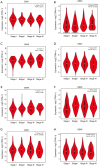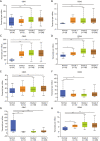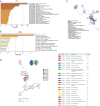Expression and prognostic value of Chromobox family members in gastric cancer
- PMID: 33209492
- PMCID: PMC7657823
- DOI: 10.21037/jgo-20-223
Expression and prognostic value of Chromobox family members in gastric cancer
Abstract
Background: The Chromobox (CBX) protein family, which is a crucial part of the epigenetic regulatory complex, plays an important role in the occurrence and development of cancer; however, the function and prognostic value of CBX family members in gastric cancer is not clear.
Methods: we investigated the relationship between CBX members and gastric cancer using a range of tools and databases: Oncomine, Kaplan-Meier plotter, cBioPortal, ULCAN, Metascape, and GEPIA.
Results: The results showed that, relative to normal gastric tissue, mRNA expression levels of CBX1-6 were significantly higher in gastric cancer tissue, whereas the level of CBX7 was significantly lower. Furthermore, overexpression of CBX3-6 and underexpression of CBX7 mRNAs was significantly related to the poor prognosis and survival of gastric cancer patients, making these CBX family members useful biomarkers. Finally, overexpression of CBX1 mRNA was significantly related to the poor prognosis of gastric cancer patients treated with adjuvant 5-fluorouracil-based chemotherapy.
Conclusions: The members of the CBX family can be used as prognosis and survival biomarkers for gastric cancer and CBX1 may be a biomarker for choosing the chemotherapy regimen of gastric cancer patients.
Keywords: Chromobox (CBX) protein; gastric cancer; prognosis.
2020 Journal of Gastrointestinal Oncology. All rights reserved.
Conflict of interest statement
Conflicts of Interest: All authors have completed the ICMJE uniform disclosure form (available at http://dx.doi.org/10.21037/jgo-20-223). The authors have no conflicts of interest to declare.
Figures








Similar articles
-
Identification and Validation of Chromobox Family Members as Potential Prognostic Biomarkers and Therapeutic Targets for Human Esophageal Cancer.Front Genet. 2022 Apr 6;13:851390. doi: 10.3389/fgene.2022.851390. eCollection 2022. Front Genet. 2022. PMID: 35464847 Free PMC article.
-
Comprehensive analysis of the prognosis for chromobox family in gastric cancer.J Gastrointest Oncol. 2020 Oct;11(5):932-951. doi: 10.21037/jgo-20-208. J Gastrointest Oncol. 2020. PMID: 33209489 Free PMC article.
-
Identification of the Roles of Chromobox Family Members in Gastric Cancer: A Study Based on Multiple Datasets.Biomed Res Int. 2020 Nov 5;2020:5306509. doi: 10.1155/2020/5306509. eCollection 2020. Biomed Res Int. 2020. PMID: 33344640 Free PMC article.
-
Analysis of the Expression of Cell Division Cycle-Associated Genes and Its Prognostic Significance in Human Lung Carcinoma: A Review of the Literature Databases.Biomed Res Int. 2020 Feb 12;2020:6412593. doi: 10.1155/2020/6412593. eCollection 2020. Biomed Res Int. 2020. PMID: 32104702 Free PMC article. Review.
-
Biological functions of chromobox (CBX) proteins in stem cell self-renewal, lineage-commitment, cancer and development.Bone. 2021 Feb;143:115659. doi: 10.1016/j.bone.2020.115659. Epub 2020 Sep 24. Bone. 2021. PMID: 32979540 Review.
Cited by
-
Evaluation of the prognostic value of CBXs in gastric cancer patients.Sci Rep. 2021 Jun 11;11(1):12375. doi: 10.1038/s41598-021-91649-7. Sci Rep. 2021. PMID: 34117289 Free PMC article.
-
Multi-Omics Data Analysis Identifies Prognostic Biomarkers across Cancers.Med Sci (Basel). 2023 Jun 27;11(3):44. doi: 10.3390/medsci11030044. Med Sci (Basel). 2023. PMID: 37489460 Free PMC article.
-
CBXs-related prognostic gene signature correlates with immune microenvironment in gastric cancer.Aging (Albany NY). 2022 Aug 14;14(15):6227-6254. doi: 10.18632/aging.204214. Epub 2022 Aug 14. Aging (Albany NY). 2022. PMID: 35969177 Free PMC article.
-
CBX3 Regulated By YBX1 Promotes Smoking-induced Pancreatic Cancer Progression via Inhibiting SMURF2 Expression.Int J Biol Sci. 2022 May 13;18(8):3484-3497. doi: 10.7150/ijbs.68995. eCollection 2022. Int J Biol Sci. 2022. PMID: 35637952 Free PMC article.
-
Comprehensive Analysis of the Expression and Prognosis Value of Chromobox Family Members in Clear Cell Renal Cell Carcinoma.Front Oncol. 2021 Jul 28;11:700528. doi: 10.3389/fonc.2021.700528. eCollection 2021. Front Oncol. 2021. PMID: 34395271 Free PMC article.
References
-
- Goral V. Etiopathogenesis of Gastric Cancer. Asian Pac J Cancer Prev 2016;17:2745-50. - PubMed
LinkOut - more resources
Full Text Sources
Miscellaneous
